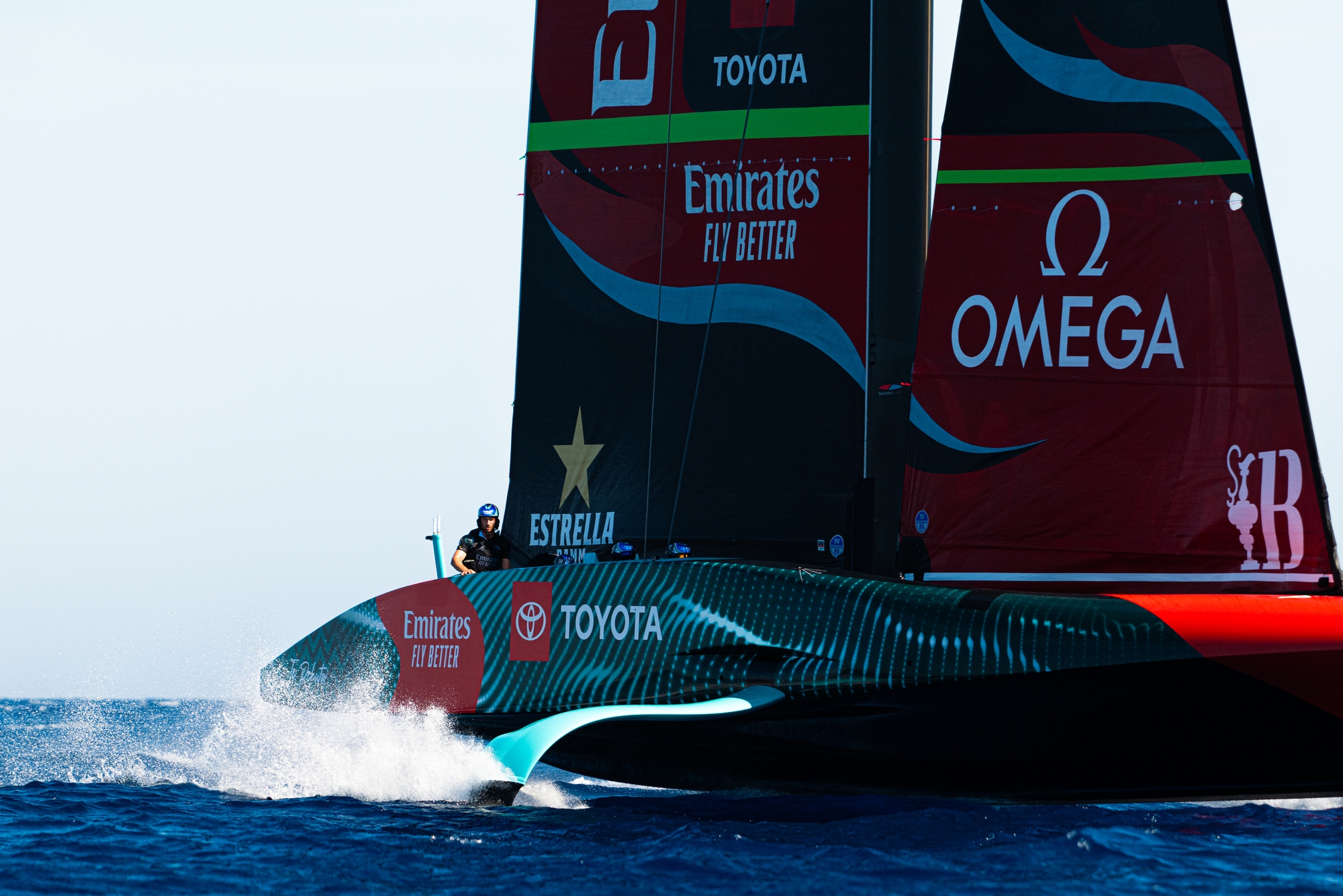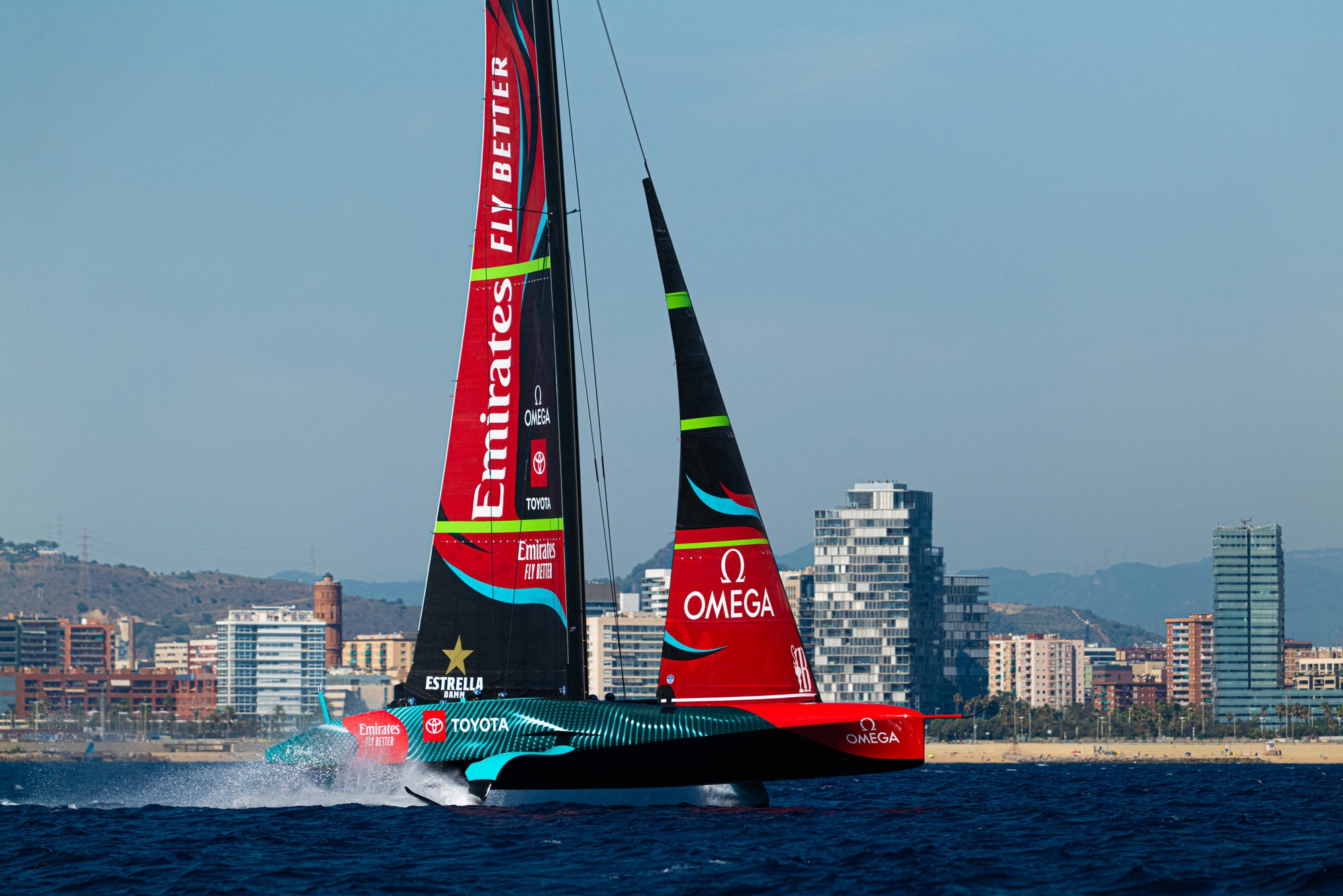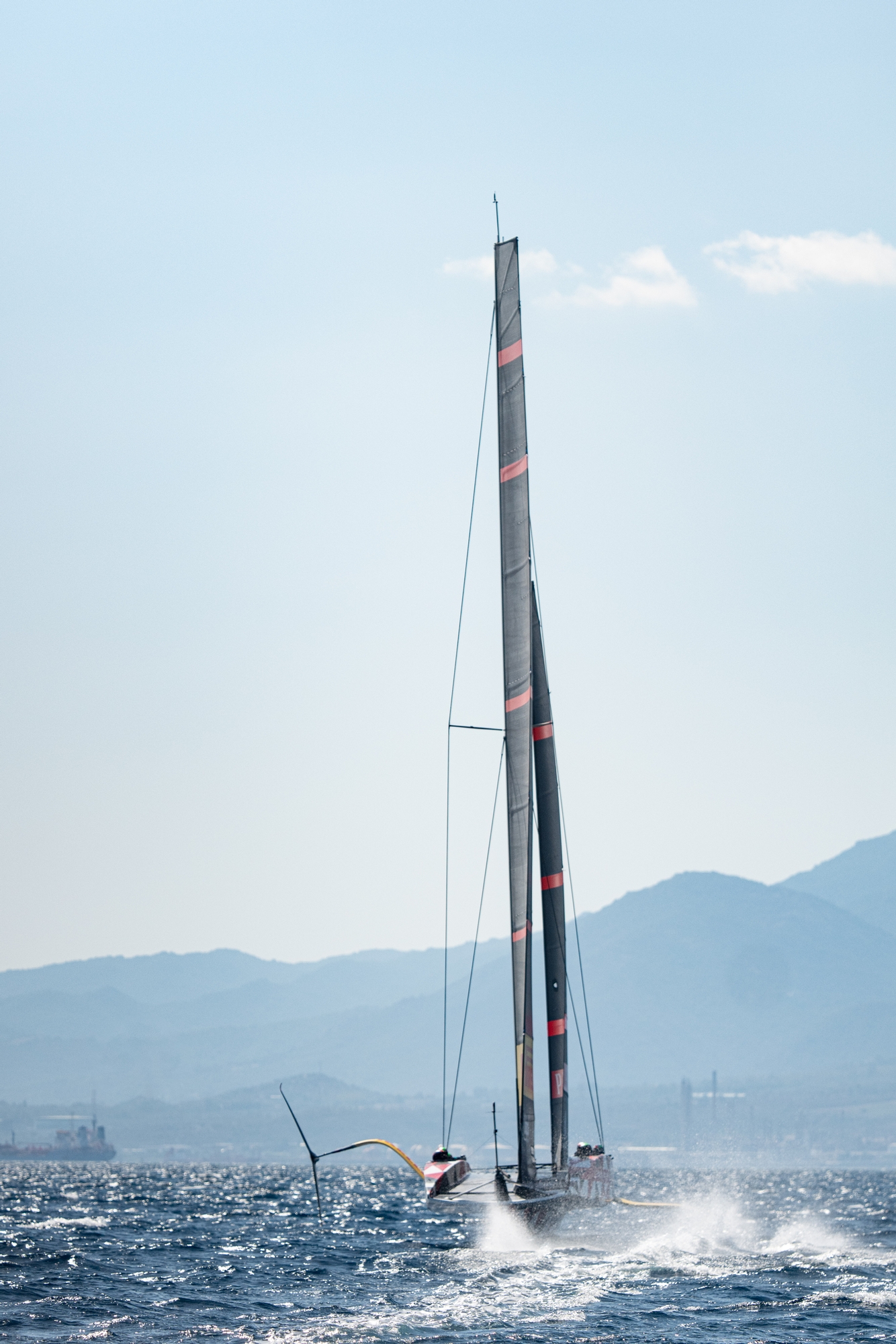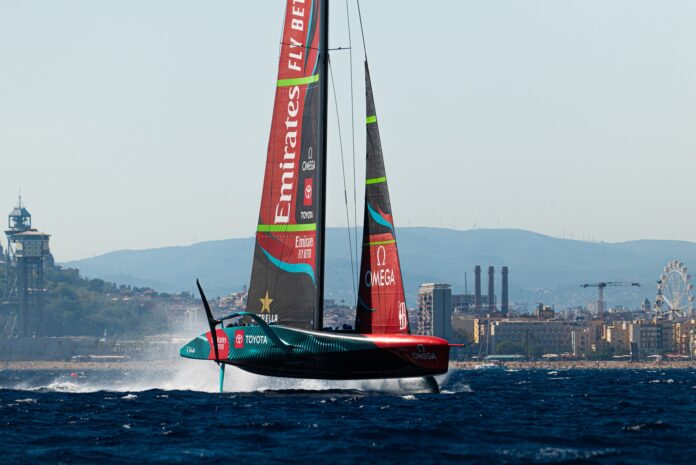There truly are few sights in world sailing that can match an AC75 in 15 knots of breeze. The sheer power, the majesty of flight and the mesmerizing speed are something that even a decade ago were unimaginable. Today out in Barcelona, Emirates Team New Zealand enjoyed a blistering session that was all-on, full on.

Heading out of the Port Vell into an afternoon of southerly breeze that just built and built, it was a day for boat-handling and managing the jib cross-overs. In total through a four-hour training stint the Kiwis launched three jibs from the J2 to the J3 and then the J4. Any more breeze and a case for the J5 could have been made. It was electric to watch (see the video) as Pete Burling and Nathan Outteridge more than confirmed their top billing, steering Te Rehutai with an accuracy through the transitions that was almost automatic. Great sportsmen make sport look easy. Burling and Outteridge do that day in, day out.

But the helms were anything but the stars of the day. Blair Tuke and Andy Maloney had the AC75 flying so low upwind that the fish were scared. Downwind they maintained a consistent pattern and through the gybes there was an immediate touch of leeward heel, driving on the immersed foil before inducing wicked windward heel and power. But spare a thought for the cyclor team, the ‘big units’, that rotated through a hugely demanding day where trim had to be precise and constant and the call for their power was relentless. Epic performance from Emirates Team New Zealand.
Andy Maloney, always the coolest of sailors, spoke afterwards and summed the day up perfectly: “It was another epic day here in Barcelona, flat water, nice building southerly breeze and you know just slowly going down the jib codes and just some really nice conditions to sail the boat…We’re always just checking in on that crossover but yeah going through quite a few codes today with that building southerly and just enjoying being back out in the AC75 in a bit more breeze, getting some higher boat speeds and just getting back dialled-in.”

Andy ominously added: “We’re starting to learn the boat really well and the systems you know there’s not too many comms we need between us and the cyclors just more in the development and stuff of the system, just making sure that we keep progressing there.” But the key is that the team are progressing well and talking about the cyclor team’s contribution, Andy added: “Anytime there’s a lot of trimming going on simultaneously or if we have a bad manoeuvre in the light winds you know everything has to get eased and turned back on so those are pretty painful for the cyclors and we don’t like doing bad manoeuvres, but they definitely don’t like it when we stuff up one.” On today’s evidence, they were very few stuffs. Greta performance from the Defenders of the 37th America’s Cup.

One team however that will be keen to challenge the Kiwis is Luna Rossa Prada Pirelli and their training today down in Cagliari, Sardinia on the Bay of Angels, was something out of the top drawer. With a sea-breeze that, just like Barcelona, built through the afternoon, the Italians had their LEQ12 at the absolute limit, rocketing around in the mid to high 40 knot mark under perfect control from the helms and Flight Controllers. Marco Gradoni, Francesco Bruni and Ruggero Tita were again rotating through the session on helm with Andrea Tesei, Vittorio Bissaro and Umberto Molineris doing the same on trim and this real unit of sailors is becoming a potent force.
At pace, they look just so comfortable in the LEQ12, able to trim it a ride it at almost any variance they desire. The upwind low-riding is a favourite, as is the downwind ultra-low flight and there are some interesting trim protocols they induce before gybing with the ride height adjusted skywards on the board drop and then the bow angled into the gybe to produce a superb exit with pace before the windward heel is brought back on.

The Italians looked masterful on the water and there are some interesting details going on with the jib clew – certainly one of the neatest we’ve seen yet with the clew attachment ‘track’ buried into the sail and a neat cut away that allows the trimmer to pull the sail, aero fashion, down to the jib traveller block. Today on the starboard foil, it was adorned with orange flow sensors and again some of the neatest camera arrangements blended and moulded into the foil arm stock to capture the vital data. It’s all in the details with the Italians and they are progressing well.

Speaking afterwards Andrea Tesei gave a terrific interview summing up the day, saying: “It was really nice to get back on our prototype after a big block of racing and training on the AC40. There was awesome conditions here, we had the really strong sea breeze coming in and yeah it was nice to sail that fast prototype around the Gulf again…We’re focusing quite a bit on straight-line testing at the moment we’re getting close to some key decisions in our big boat design so at the moment we looking into any boat speed we can find and testing anything out on our foils.”

Talking about both the onboard data feeds and the role of trimmer/Flight Controller, Andrea added: “There is no delay on controls but there is going to be delay on all the data and the numbers that are coming through the logging system so all the true wind speed numbers, all the data coming from the wind wand, speed and position have a random delay in it so you cannot use them live…When we’re not flying the boat, we’re looking around helping the helmsman, checking all the performance parameters are working fine, and keeping the boat going fast – basically trimmers!” Stunning sailing from Luna Rossa Prada Pirelli.
Back in Barcelona, NYYC American Magic had a full day planned with their two AC40s ‘America’ and ‘Magic’ but the day was cut short for ‘Magic’ when a manifold issue caused an oil leak and sent them quickly back to their Port Vell base for repairs.

Unabashed, ‘America’ pushed on out into the building afternoon and early evening southerly breeze that topped out at 23 knots and what became very apparent to the Recon Unit following closely was that the sailors were struggling with their slender starboard-side foil in breeze under 15 knots but excelled when above.
This has been observed before but in interview afterwards, Michael Menninger acknowledged the issues the team face, saying: “That’s our smallest hydrofoil and so it’s a bit temperamental when it breaches, when it comes out of the water, so the challenge for us is just to stay kind of connected and locked in with that foil and there’s a few different ways to do it – you can do it with cant, you can do it with T-sync you can do it kind of through various different ways and you can also try to be a bit more forgiving on their aero side as well – so we’re trying a little bit of all these things to try to make it as forgiving as possible but it’s still probably one of our more challenging foils to sail on and even today, which is pretty easy sea state conditions, we still had some issues with it but it’s just something we’re always working through.”

Asked whether perhaps the team had gone a little too extreme with the starboard foil, Michael gave an interesting answer, saying: “Possibly. It’s a really good question, it’s a question all the teams are going to have to answer as in what is going to yield you the highest performance boat but also it needs to be easy enough from a sailing perspective to use well and race really well when it comes down to race and make manoeuvres in tight spots. So, to be honest we don’t think we have a real answer on that. I think we’re still learning every day with that foil and we’re still getting better as a sailing team as well so I wouldn’t say we’ve gone too far but certainly that’s the question that we’re asking ourselves every day.”

Will the starboard foil be swapped out is the question when Michael revealed that the next upgrade could be coming next week: “I think the plan is to launch Foil 4 next week so we’ll have that online and we’re looking forward to testing that foil and hope it’s our best foil but we’ll find out soon…You’ll see next week, it’s nothing crazy, it’s just kind of a continuation on all three of our foils that are relatively similar and so it’s just kind of continuation on that design path.” NYYC American Magic are pushing hard in this America’s Cup cycle. The winners in Vilanova at the Preliminary Regatta, all eyes will be on that foil and their performance with it, next week.
Alinghi Red Bull Racing packed up their AC40s in the morning and sent them en-route to Jeddah, Saudi Arabia for the second Preliminary Regatta at the end of November before launching and running through some engineering tests on their AC75 ‘BoatZero’ that will be out hopefully tomorrow (Thursday). The hard-driving, fast learning Orient Express Racing Team were out in their AC40 and were captured on camera by several of the other team’s recon units. No sailing for INEOS Britannia with their next scheduled day being Friday this week. (Magnus Wheatley)

On-Water Recon Unit Report – Emirates Team New Zealand: This week’s second consecutive day of AC75 sailing for Emirates Team New Zealand was in sharp contrast to the sub-10 knot winds of the previous day with the early afternoon’s 9-10 knots building to 15 knots by the end of the team’s three hours and 45-minute session.
Sea conditions began with a light wind-driven chop and zero swell building to a moderate 0.5 metre chop by the final hour of sailing. AC75 B2 rolled out at 1100 – thirty minutes delayed on the scheduled time. Rigging was completed by 1130 and the boat craned into the water 10 minutes later. Dock-out was 1230 and by 1245 sails – M2-3 and J2-6 – were up by 1245.
The boat left the harbour at 1255 and was on foils almost immediately in 9-10 knots of wind and a slight chop. After a 15 minute fast (40 knots+) downwind run with one foiling gybe, the crew – helmsmen Peter Burling and Nathan Outteridge with Andy Maloney and Blair Tuke on sail trim / flight control (plus cyclors) – stopped to change headsails to the J3-6.
The boat set off again 15 minutes later for 35 minutes of windward leeward laps which stopped at 1400 for a rotation of the cyclors. Upwind speeds were in the low to mid-thirties.
Fifteen minutes later the crew began a second session of windward / leeward laps which lasted 20 minutes before another stop to change to the J4-6 headsail. After 15 minutes the boat set off again, but this time went straight into a series of three pre-start and then windward / leeward laps around a virtual racecourse. This session took 30 minutes before another stop and cyclor rotation. A duplicate 30-minute session beginning at 1525 concluded with a long upwind session back to the harbour entrance that ended in a series of five short tacks along the harbour breakwater.
The boat came to a stop outside the harbour at 1550 with sails dropped by 1600 and dock-in taking place at 1615. Another AC75 sailing day has been scheduled for tomorrow (Thursday September 28).
On-Water/Dock Recon Unit Report – Alinghi Red Bull Racing: The Swiss rolled out their AC75 for on-dock testing today with the team starting the day packing their AC40 gear into a container bound for Jeddah, Saudi Arabia.
Once the transporter had left, the shore team rolled out the AC75 at 10:40h with the same configuration as they did last week for their Open Doors Red Bull event. The set up was: the T-Wing with flat bulb and ETNZ legacy Foil on starboard and the Y-Wing with round bulb and American Magic legacy Foil on the port side.
After the mast procedure, by 11:25h, the AC75 was craned into the water and placed alongside the chase-boat, where they spend two hours on electronic, hydraulic, comms and foil arm testing moving them up and down. At 13:20h they craned the yacht back to the base and hauled out.

On-Water Recon Unit Report – Luna Rossa Prada Pirelli: The Italian team opted for an afternoon sea-breeze training day and rolled out their LEQ12 prototype at 12:30, quickly stepped the mast and cables before craning in by 12:40. On the recently changed starboard wing several orange marked dots were observed across all of the wing span.
After the usual dockside checks, the team docked-out an hour later as the southerly sea-breeze was filling in. The main M1-2 was hoisted by 13:40 followed by the J2-1. The LEQ12 was boarded by six crew, with four sailors and two guests on the joyride seats. Before taking off, traveling at 16kn at 75TWA on portside tack, the breeze was measured at 12-14kn from 175° with flat sea state.
During the first 48-minute-long foiling stint, the LEQ12 followed a course path, executing some tacks with straight-lines in between, before bearing away on starboard tack for a long downwind run, gybing once and trimming up again on port tack. This procedure was observed twice before changing the routine for the last two times on the other tack hence bearing away on port tack.
Once the LEQ12 came to a stop, sailors swapped between pods and onboard/offboard the chase-boat. The sea-state increased with chop from 180 of approx. 0.5/0.7meters. The second foiling stint lasted approx. 2 minutes ending shortly after sailing a while on port tack quite low for end-plating before dropping the windward board to decelerate, sailors gathered and seemed to debrief.
No major as a minute after the LEQ12 performed the third self-take-off of the day and the training routine procedure kept on going for two runs. After a long downwind run, the LEQ12 stopped closer to the harbour to drop off the guests at the base while chase-boat 2 placed a windward and leeward gate. The Recon Team waited at the leeward gate as the LEQ12 passed through and headed on its first upwind leg, bearing-away on the right-hand windward mark, and splashing down after the first gybe. Here the pressure was measured at 15-17kn with some significant wind chop and the J2-1 was lowered to hoist the J4-1. Once up and foiling the LEQ12 headed straight downwind, rounded the mark for another upwind leg and after crossing the line it sailed mostly downwind completing its last foiling stint in front of the harbour. Sails were lowered and the day was called after an approx. total of 28 tacks, 26 gybes, and 140 total minutes foiling time [Michele Melis AC Recon].

On-Water Recon Unit Report – NYYC American Magic: AM rolled out their AC40 ‘America’ from the shed at 10.15. The boat was craned to the water at 10:53 and the team docked out at 12.45, as planned. The CMN3 main and the J3 were hoisted inside the port and were the only sails used during the day.
The original plan was to have a two-boat training session and then perform some races using marks. However, NYYC AM´s second AC-40 ‘Magic’ that came out from the port approximately forty-five minutes behind America, discovered some issues after sailing for half an hour on their own. After dealing with it for half an hour next to one of the team´s chase boats, sails were lowered, and Magic was slowly towed back to the base without being able to foil on the tow. The problem’s source could not be identified, but Michael Menninger on the interview mentioned an oil leakage. The team adjusted their plan for the day and continued to train with America on their own.
Standing with the same configuration as yesterday, today´s training consisted of mostly sailing on a straight-line, trying different modes, combined with some tacks and gybes. As regards the manoeuvres, the stronger the wind intensity, the easier it gets with these foils´ configuration for NYYC AM to tack and gybe consistently flying, on both tacks.
Particularly, at the beginning of the day, when wind intensity was under 15 knots of TWS, tacking from starboard into port seemed really hard, touching down on most of the tacks, as yesterday. However, as the wind intensity increased towards the afternoon, their tacking performance from starboard into port improved drastically. They were able to do most of the tacks flying consistently.
Nevertheless, in opposition, as the wind increased, it became harder to maintain the boat flying consistently on port tack when sailing upwind at full speed on VMG mode. They were regularly falling aggressively when the wind intensity was over 17 knots.






